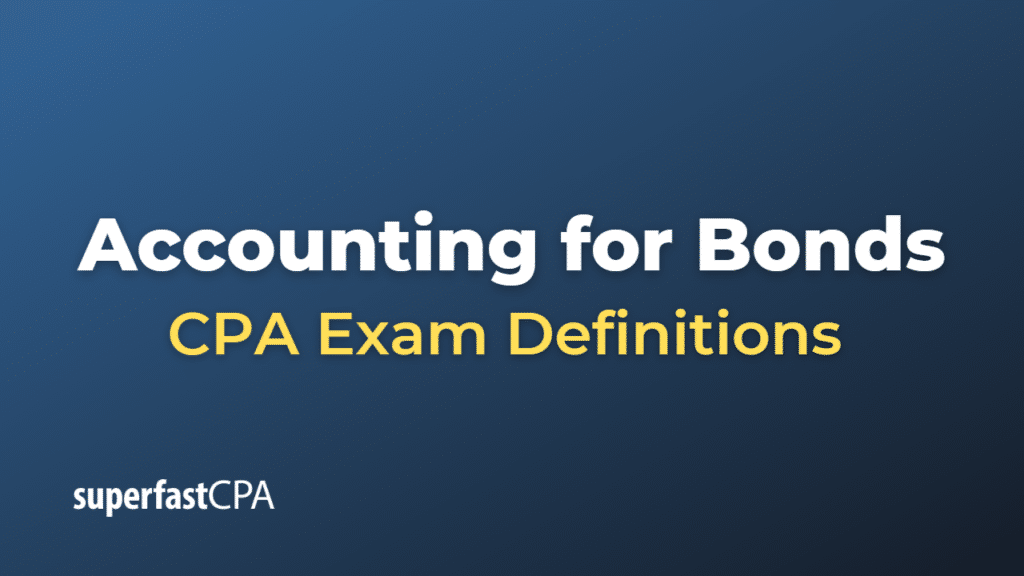Accounting for Bonds
Accounting for bonds involves recording and tracking the issuance, interest payments, and repayment of bonds in a company’s financial statements. Bonds are debt instruments that companies issue to raise capital, usually for a specific period, with the promise to pay periodic interest and return the principal amount at maturity.
The process of accounting for bonds typically includes the following steps:
Step 1:
Issuing the bond: When a company issues a bond, it records the cash received and the corresponding bond liability. The bond may be issued at par, at a premium (above par), or at a discount (below par), depending on the market interest rates and the bond’s stated interest rate.
- Issued at par:
| Date | Account | Debit | Credit |
|---|---|---|---|
| 03-23-2023 | Cash | $X | |
| Bonds Payable | $X |
- Issued at a premium:
| Date | Account | Debit | Credit |
|---|---|---|---|
| 03-23-2023 | Cash | $Y | |
| Bonds Payable | $X | ||
| Premium on Bonds | $(Y – X) |
- Issued at a discount:
| Date | Account | Debit | Credit |
|---|---|---|---|
| 03-23-2023 | Cash | $Z | |
| Discount on Bonds | $(X – Z) | ||
| Bonds Payable | $X |
Step 2:
Recording interest expense: Periodically, the company records interest expense and the related interest payment or accrual. The interest expense is calculated based on the carrying value of the bond (face value plus or minus the unamortized premium or discount) and the effective interest rate.
For bonds issued at par:
| Date | Account | Debit | Credit |
|---|---|---|---|
| 06-30-2023 | Interest Expense | $A | |
| Cash | $A |
For bonds issued at a premium or discount, the company amortizes the premium or discount using the effective interest method. The journal entries would look like:
- Amortizing bond premium:
| Date | Account | Debit | Credit |
|---|---|---|---|
| 06-30-2023 | Interest Expense | $B | |
| Premium on Bonds | $C | ||
| Cash | $(B + C) |
- Amortizing bond discount:
| Date | Account | Debit | Credit |
|---|---|---|---|
| 06-30-2023 | Interest Expense | $D | |
| Discount on Bonds | $E | ||
| Cash | $(D – E) |
Step 3:
Redeeming the bond: At maturity, the company repays the bond’s principal amount and records the transaction by decreasing the bond liability and the cash account.
| Date | Account | Debit | Credit |
|---|---|---|---|
| 03-23-2025 | Bonds Payable | $X | |
| Cash | $X |
If any unamortized premium or discount remains, it should be fully amortized when the bond is redeemed.
By properly accounting for bonds, companies can accurately represent their long-term debt obligations, interest expenses, and cash flow activities in their financial statements.
Example for Accounting for Bonds
Let’s consider a fictional example of a company, “TechWorld,” that issues a bond to raise capital for its operations.
TechWorld issues a 5-year, $1,000,000 bond with a stated annual interest rate of 5%, payable semiannually. The market interest rate is also 5%, so the bond is issued at par value. Here’s how TechWorld would account for the bond issuance, interest payments, and bond redemption:
Step 1:
Issuing the bond: Since the bond is issued at par, TechWorld records the cash received and the bond liability:
| Date | Account | Debit | Credit |
|---|---|---|---|
| 03-23-2023 | Cash | $1,000,000 | |
| Bonds Payable | $1,000,000 |
Step 2:
Recording interest expense: TechWorld pays interest semiannually (every six months). The annual interest is $50,000 (5% of $1,000,000), so each semiannual payment is $25,000 ($50,000 / 2).
For bonds issued at par, the journal entries for interest payments would look like:
| Date | Account | Debit | Credit |
|---|---|---|---|
| 09-23-2023 | Interest Expense | $25,000 | |
| Cash | $25,000 | ||
| 03-23-2024 | Interest Expense | $25,000 | |
| Cash | $25,000 |
Step 4:
Redeeming the bond: At maturity (5 years after issuance), TechWorld repays the bond’s principal amount of $1,000,000:
| Date | Account | Debit | Credit |
|---|---|---|---|
| 03-23-2028 | Bonds Payable | $1,000,000 | |
| Cash | $1,000,000 |
In this example, TechWorld properly accounted for the bond by recording the issuance, interest payments, and bond redemption. By doing so, the company accurately represented its debt obligations, interest expenses, and cash flow activities in its financial statements.













